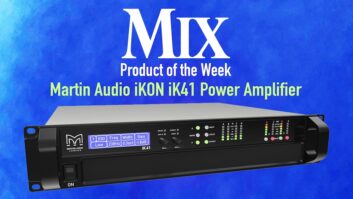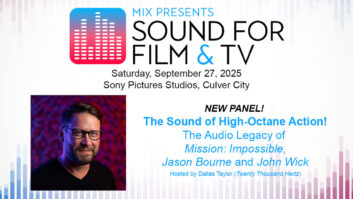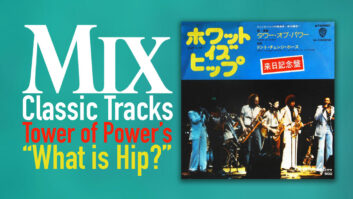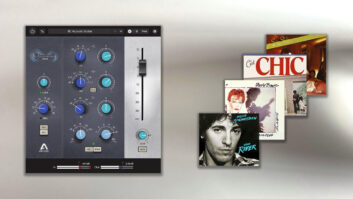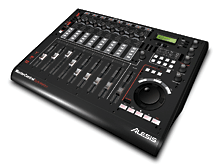
Just when we’d thought we’d seen it all, new digital consoles and mix controllers keep coming. The good news is that your “new” console could be only an expansion card or software upgrade away, which can certainly soften the blow to anyone’s budget. Speaking of capital, there really is something for every application and every budget, although with so many choices available, finding the right model becomes far more complex. With that in mind, we decided to look at developments in the field from the past few months, and we found a pretty healthy assortment of new releases.
Alesis’ new MasterControl comes bundled with Cubase LE.
MasterControl from Alesis (www.alesis.com) combines a control surface and FireWire interfacing with MIDI I/O, two XLR mic inputs, six line ins and 18 digital inputs (Lightpipe and S/PDIF at 44.1/48 kHz, or up to 10 ins at 88.2/96/192 kHz). The unit has eight channel strips (with solo, record-enable, Mute/Select buttons and motorized faders), a jog/shuttle wheel, dedicated transport controls and cue mix section with talkback mic. The monitoring section has six analog outs configurable as discrete 5.1 surround or three separate stereo outputs. Bundled with Cubase LE software but compatible with most popular DAW software, MasterControl was slated to begin shipping last month at a retail of $1,099.
The AMS-Neve (www.ams-neve.com) DFC PS/1 PowerStation is a single-user, slim-line, 384-path version of the company’s DFC Gemini post console. It integrates with Pro Tools, Nuendo or Pyramix environments as a combined digital console/DAW controller. Full surround monitoring and machine control are standard, as are support for sample rates up to 384 kHz, Star Command simultaneous control of multiple workstations, high-resolution TFT metering, 384 fader paths, reconform from picture change lists and insertion of premixes into larger mixes.
Earlier this year, Calrec (www.calrec.com) unveiled Omega, a new mid-level console that uses the manufacturer’s award-winning, FPGA-based Bluefin high-density signal processing technology. Omega features 160 mono DSP paths packaged as 48 stereo and 64 mono channels, and up to 24 full 5.1 surround channels — all with full EQ and dynamics. Available in 24/40/56-frame sizes, Omega with Bluefin’s output complement includes eight 5.1 surround groups, 20 aux outs and 48 multitrack outs.
Digidesign‘s (www.digidesign.com) ICON continues its successful run, with more than 2,000 of these integrated digital console/Pro Tools controller systems sold since initial deliveries began in May 2004. More recently, the company announced an educational program that provides in-depth, hands-on Icon D-Control training by Digidesign-certified instructors. The Pro Tools 310I: Advanced ICON Mixing Techniques course is offered with numerous options, including expert-level Certified ICON Mixer training, at the company’s headquarters, training locations worldwide or even at the user’s studio. For more information, visit www.digidesign.com/training/icon.

Euphonix S5 Fusion digital audio post mixing system for HDTV
The Euphonix (www.euphonix.com) S5 Fusion digital audio post mixing system for HDTV fuses DSP and DAW control technology with the company’s EuCon protocol. This combination enables the console surface to control both its SuperCore engine DSP channels and channels from multiple external Mac or PC workstations simultaneously over high-speed Ethernet. To manage large numbers of tracks and DSP channels, S5 Fusion also provides comprehensive machine control, a router, film-style surround monitoring, 24 channel strips, motor joysticks (optional) and high-res screens showing metering, track info and routing displays. Each channel strip has a multiformat moving fader; touch-sensitive knobs for EQ, filters, compressor, expander/gate, aux and pan; and DAW control for TDM, VST and Audio Units plug-ins.
Fairlight (www.fairlightau.com) employs the groundbreaking Crystal Core FPGA processing technology in its DREAM II Series, which includes the flagship Constellation-XT and Anthem console/workstations. A single Crystal Core CC-1 PCI card can handle 230 audio channels (each with eight bands of EQ and full dynamics control), 72 user-definable mix buses (mono to 7.1), 192-track recording, integrated HD video and up to 220 physical I/Os. The new Dream II Version 1.1 software update adds fast, direct AAF and AES-31 file exchange, as well as multiple EQ selections on a per-channel basis. Users can choose from Constellation-XT, Anthem Split or Anthem In-Line EQs, each with a distinctive flavor and character.
The Alphatrack compact DAW controller from Frontier Design Group (www.frontierdesign.com) features touch-sensitive rotary encoders, transport controls, jog/shuttle strip and a single, assignable motorized fader. The $249, USB-powered desktop unit is XP- and OS X-compatible for Pro Tools, SONAR, Cubase, Reason, Digital Performer, Nuendo and other apps.
Harrison (www.harrisonconsoles.com) has revised and updated its TVD-SL large-format TV studio digital audio console, which now features TFT metering and Xrange native engine DSP and Xrouter digital audio signal routing. The 24-bit (96kHz-capable) TVD-SL is available in standard 44 or 60 faders for stereo or 5.1 surround mixing, and the main control surface can be operated from up to three additional locations using Harrison’s Satellite Touchscreen technology.
Lawo (www.lawo.de) is now shipping its mc290 digital console, which is designed to take the technology of the mc266 mixer to a new level. The mc290 has a redesigned user interface and integrates Lawo’s Star2 topology, providing total console redundancy in no-fail environments. Compatible with both consoles, V. 1.10 software provides improved sequence automation; 10 new DSP configurations; the ability to meter up to eight VCA-slaved channels controlled by a single fader (ideal for surround stems, etc.); more frequency points for EQ, filter and sidechain filter modules; full MIDI Machine Control remote access; a choice of MTC, LTC, Sony 9-Pin TC or internal timecode slaving; and more.
Also new is Lawo Plug-In Host (LPH), a low-latency PC host app that assigns tielines for the triggered plug-ins to the mc2 HD Core that automatically appear on the GUI matrix screen. The console imports plug-in parameters in the same way as console-based EQ or dynamics parameters are assigned, and plug-in settings can be stored either statically using snapshots or dynamically with the automation data.
The Logitek (www.logitekaudio.com) Artisan control surface for its Audio Engine router is designed for small to medium-sized market TV, radio production and other applications. It provides 5.1-compatible operation, two master mix buses, eight submaster mixes, 24 mix-minus buses, multiple aux buses, onboard dynamics/EQ and frame delay at each fader. Full-color LCDs on each drop-in module show needed information in an easy-to-read format.

Mackie’s Control Universal Pro mix controller connects to a Mac or PC via USB.
The $1,550 Mackie Control Universal Pro mix controller from Mackie (www.mackie.com) connects to a Mac or PC via USB and has nine motorized, touch-sensitive Penny & Giles faders, eight V-Pots, more than 50 master buttons and a large LCD. An $899 Mackie Control Extender Pro can add eight more channels for up to 32 channels total. The system is compatible with ACID Pro 6, Audition, Cubase, Digital Performer, Final Cut Pro 5, Logic, Live 5, Nuendo, Pro Tools, Reason 3, Samplitude, SAWStudio, Sequoia, SONAR, Soundscape, Soundtrack Pro, Tracktion and Vegas. Designed to be used with MCU Pro or stand-alone, the $1,300 Mackie Control C4 plug-in and virtual instrument controller provides real-time control of up to 32 simultaneous parameters with visual feedback via four backlit, alphanumeric LCDs.

Merging Technologies’ Ramses MSC is scalable from 16 to 256 I/O channels.
Pyramix 6, a 48-channel DSD recording system from Merging Technologies (www.merging.com), takes another step forward with the new Ramses controller and Oasis I/O boxes, offering DSD and DXD recording with optional mic preamps. The multiformat Ramses MSC is a fully integrated record, editing, processing and fully automated mixing system that’s scalable from 16 to 256 I/O channels and tracks in eight to 24 (plus dual-operator, 48-channel) configurations, with full static or dynamic automation of all parameters, including joystick surround panning control. Full support of VST plug-ins on all channels and buses are standard, as is support for sample rates from 44.1 to 384 kHz, plus 48-channel DSD and DXD options. Also available is Merging’s VCube and VCube SE standard/HD video integration. Another Ramses option is a version of Smart AV‘s (www.smartav.net) ARC™ technology for instant access to large numbers of channels. Current Pyramix owners can upgrade their systems to Ramses MSC, incorporating their existing Merging hardware.

PreSonus’ FaderPort offers USB transport control.
FaderPort from PreSonus (www.presonus.com) provides USB transport control with a long-throw, Alps touch-sensitive motorized fader for writing fades and volume/mute/pan automation in real time. Solo and record-enable can also be easily controlled, along with window selection, play/stop/record and marker/locate points for fast and easy recording. A footswitch jack supports hands-free, punch-in/out recording. FaderPort retails at $229 and works with all Mac or Windows-based recording software, including Pro Tools, Cubase, Nuendo, Logic, Digital Performer, SONAR and more.
Solid State Logic (www.solid-state-logic.com) is shipping its Duality console/DAW controller, with recent deliveries going to Alicia Keys’ The Oven Studios in New York and Atlanta’s PatchWerk Recording Studios. Available with 48/72/96 faders, Duality (see review on page 94) is a large-format analog console offering full DAW integration, a split signal path, E and G equalizers, onboard dynamics, moving-fader automation and 5.1 panning — all with the SuperAnalogue K Series sound.
On the digital console front, SSL has rechristened its C Series digital broadcast consoles to C100 HD and C300 HD, while doubling the possible fader inputs to 512, adding MORSE routing capabilities and updated Century processing, and incorporating the workstation control from the company’s AWS Series. Another launch is the C100 HD-S, essentially the C100 HD with an identical feature set but in a smaller footprint console designed for space-limited installs, such as small control rooms and trucks, packing 64 faders into a frame that’s less than 92 inches. With the new V. 4 software, the C100 HD consoles support a high-density processing engine and control surfaces with access to up to 256 fully featured input channels and another 256 short-channel premix inputs, with fader control, panning and mono/stereo/surround busing.
Designed for film/TV production, the upgraded C300 HD from SSL is a scalable (8 to 96-channel, multi-operator-capable) solution, with more than 500 mix inputs and 80 mix buses (all with DSP) from a single Centuri processor. It also offers flexible DAW control and full multiformat surround monitoring. Other C300 HD features include an enhanced 96kHz feature set, tri-level sync support, optional PEC/direct switching, EQ and dynamics libraries, pull-up/down sample rate handling, advanced multi-machine control and more.
StageTec (www.stagetec.com) offers new software and a revised control surface for its AURUS digital consoles. An offline editor allows setting up presession console configurations using a Windows PC without physical access to the mixer. The NEXUS Audio network can also be similarly set up offline directly from the AURUS master section. On the hardware side, graphics-enabled OLED displays showing channel and layer configurations on the channel strip will replace the matrix displays previously used.
But the big news from StageTec is AURATUS, a compact console for TV/broadcast/remote recording and live sound applications where the full configurability of AURUS is not required. Among its features are audio-follows-video functions, eight separately configurable mix-minus buses, and a simple user interface with a short learning curve and OLED and TFT displays. AURATUS has a hardwired bus layout with a maximum of 32 input channels, eight groups, one stereo and one 5.1 sum, eight aux paths, eight mix-minus sums and full integration with the NEXUS audio routing system.
Studer (www.studer.ch) now offers a 42-fader version of its Vista 5 digital console, which provides access to up to 1,700 channels. The 42 faders on its one-knob-per-function surface has 30 channel strips as input channels and 12 strips for operating I/O channels. The additional faders also permit two-operator applications, if needed. The Studer D21m I/O system — used on the Studer Vista Series and OnAir 3000 digital consoles — has been enhanced with a new optional I/O card for signals encoded with Dolby E, which lets users directly decode an AES/EBU stream into eight discrete channels.

Tascam DM-4800 can be repatched at the flick of a switch.
The Tascam (www.tascam.com) DM-4800 64-channel digital console has 24 buses, 12 auxes and 24 studio-grade preamps (more can be added via expansion cards), and can be completely repatched at the flick of a switch. Additionally, the DM-4800 offers extensive DAW control and two TC Electronic reverbs. A fat channel strip in the center of the console gives instant access to 4-band parametric EQ, dynamics and aux controls available for the first 48 channels. Its remote layer provides transport keys and 24 faders for controlling workstations such as Pro Tools, Logic, SONAR, Digital Performer, Cubase and Nuendo, while the optional IF-FW/DMmkII interface card provides 32 channels to/from a computer at up to 96 kHz over a single FireWire cable. Other options include a full meter bridge and a surround monitoring card offering downmixing, bass management and level control for mixing in up to 6.1 surround.
New from Wheatstone (www.wheat stone.com) is the E-6 Surface, the E Series Studio Satellite I/O and the E Series Network Switch, which combine to form a cost-effective networked audio system. Each operates independently, yet all sources and mixes can be shared via the network. The E-Surface features event recall, bus-minus, mix-minus and four aux mixes — all with dedicated talkback systems — as well as standard EQ, dynamics, panning and mic processing on all channels. Control surfaces are offered in 16- or 24-channel frames. Also new is the Evolution Series E-5 control surface, a simplified version of the E-6 available in 8/16/24-channel mainframes.
Yamaha‘s (www.yamaha.com/ca) DM2000 VCM is the second generation (V. 2) of the company’s DM2000 digital production console, combined with a collection of pre-installed, add-on effects. Available as a free upgrade, the suite includes five plug-ins that emulate legacy processors and more. Virtual Circuitry Modeling (VCM) technology creates models of classic compressor, EQ, analog tapedeck and stompbox effects, capturing nuances and subtleties of the gear. Also provided is the REV-X advanced algorithm used in Yamaha’s latest reverb and ambience programs, which take advantage of the DM2000’s 24-bit/96kHz processing capability, as well as Interactive Spatial Sound Processing surround post-production effects. The other side of the V. 2 upgrade incorporates advanced DAW integration (Nuendo, Cubase, Pro Tools, etc.), 6.1 panning/monitoring and mix-minus capability.
Deva Mix-12 from Zaxcom (www.zaxcom.com) is a fully digital, 12-fader control surface that directly manages the audio mixer embedded within the company’s Deva IV and V location recorders. Combined with either the Deva IV or V, Deva Mix-12 performs all location mix and record functions, reducing production costs by eliminating the need for external mixing consoles.
George Petersen is Mix’s executive editor.

